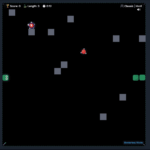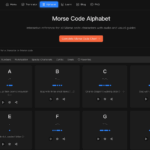In our hyper-connected world of instant messages, video calls, and endless social media streams, it’s easy to forget the ingenious methods humans used to communicate across distances before the digital age. One of the most iconic and enduring of these is Morse code – that seemingly cryptic language of dots (dits) and dashes (dahs). You’ve probably heard it in old movies or seen the famous SOS signal (… — …), but have you ever actually tried to understand or use it? It might seem like a relic of the past, but Morse code still holds a certain fascination and even practical value today. And if you’re curious to dive into this world, there’s a fantastic online resource that makes it surprisingly accessible: MorseCodeTool.com.
A Quick Dash Through History
Before we explore the tool itself, let’s appreciate what Morse code is. Developed by Samuel Morse and Alfred Vail in the 1830s and 40s alongside the telegraph system, it revolutionized long-distance communication. For the first time, complex messages could be sent reliably over wires using electrical pulses. Each letter, number, and punctuation mark has a unique sequence of short signals (dots) and long signals (dashes). This system became vital for everything from news dissemination to maritime navigation and military communication for over a century.
While its primary commercial use has faded, Morse code remains relevant in amateur radio (ham radio), as a backup communication method in aviation and seafaring, and even as an assistive technology. Plus, learning it offers some unique cognitive benefits!
Decoding the Modern Tool: What MorseCodeTool.com Offers
So, you’re intrigued? This is where MorseCodeTool.com shines. It’s not just a simple translator; it’s a comprehensive hub designed for both quick conversions and in-depth learning. Forget dusty textbooks or complicated software – this website puts everything you need right in your browser.
The core feature is the **Instant Morse Code Translator**. It works exactly as you’d hope: type or paste text into one box, and it instantly appears translated into Morse code in another (or vice versa). But it goes a step further – you can actually *listen* to the Morse code translation played back as audio signals. This is crucial for learning, as Morse code is fundamentally an auditory language. Hearing the distinct rhythm of the dits, dahs, and the spacing between them is key to mastery.
Beyond simple translation, the site boasts a dedicated **Learning Center**. This isn’t just a static page; it offers interactive lessons and exercises designed to take you from absolute beginner to proficient operator. You can familiarize yourself with the **Morse Code Alphabet** (they have a clear chart for A-Z, numbers, and punctuation) and then practice recognizing and sending signals. The step-by-step approach mentioned on their site – learn the alphabet, practice timing, start communicating – is perfectly facilitated by these tools.
Why Bother Learning Dots and Dashes Today?
Okay, learning a 19th-century code might seem niche, but the website highlights some compelling reasons why it’s still worthwhile:
- Universal Communication (Kind Of): While not everyone knows it, the standardized nature of Morse code allows communication across language barriers if both parties know the code.
- Emergency Preparedness: In situations where modern tech fails (think power outages, remote areas), Morse code can be transmitted using basic tools like flashlights, mirrors, or even just tapping. Knowing SOS is one thing; being able to send more complex messages could be invaluable.
- Cognitive Benefits: Learning any new system challenges your brain. Morse code specifically can enhance memory, focus, and auditory processing skills. It’s like a workout for your ears and mind.
- Historical Connection: Engaging with Morse code connects you to a pivotal piece of communication history. It offers a tangible link to the ingenuity of past inventors and operators.
Plus, let’s be honest – it’s just cool. Being able to tap out a secret message or understand the beeps and boops in an old film adds a unique skill to your repertoire.
Making Learning Engaging and Easy
What I appreciate most about MorseCodeTool.com is how it lowers the barrier to entry. Learning Morse code traditionally involved memorization charts and perhaps finding a tutor or radio club. This website consolidates everything you need into an interactive, user-friendly platform.
The ability to instantly translate and hear the results makes experimentation fun. You can type messages to friends, translate famous quotes, or just play around. The learning exercises provide structured practice, helping you build recognition speed and accuracy at your own pace. Having the alphabet chart readily available means you’re never stuck wondering what sequence represents a ‘Q’ (it’s –.-, by the way!). They also include a helpful FAQ section addressing common questions, like the meaning of SOS or how the translator works.
Tap Into a Piece of History
Whether you’re a history enthusiast, a budding ham radio operator, a prepper, someone looking for a unique mental challenge, or just plain curious, MorseCodeTool.com offers a fantastic gateway into the world of Morse code. It’s well-designed, packed with useful features, and makes learning this historical code feel relevant and engaging in the 21st century.
Why not give it a try? Head over to MorseCodeTool.com and translate your name, learn the alphabet, or maybe even start practicing your first few words. Dit dit dit!


